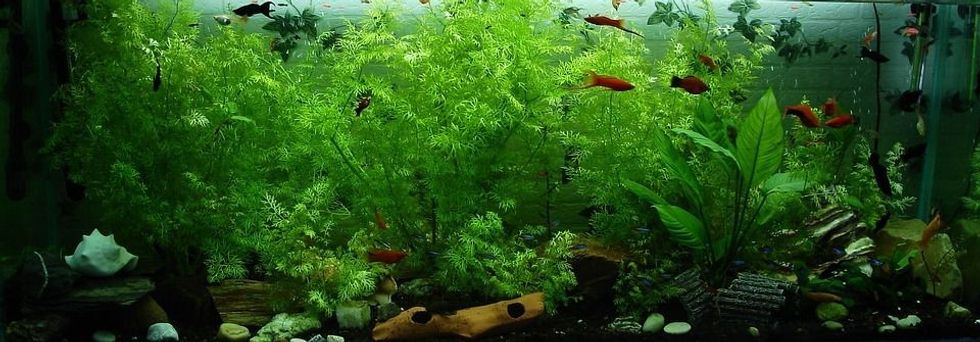Anchor worm (Lernaea cyprinacea) is a parasite living under the scales and gills of freshwater fish. Water salinity impacts the parasite's reproduction to a great extent. Freshwater bodies are needed for them to reproduce. These parasites have a complex life cycle.
After the females lay the eggs, it takes 24-36 hours to hatch. Growing up, the juveniles go through five stages. In each stage, they go through immense changes in body structure.
In order to survive, anchor worms need to find a host. The freshwater fishes act as their hosts.
They attach themselves to the body of these fishes and suck body fluids to keep themselves alive. This causes diseases and infections among the fishes such as goldfish. Although they do not kill the fishes, they make them vulnerable and more prone to bacterial and fungal infections.
Being macroscopic parasites, they can be easily spotted, even with naked eyes. The most advisable way for anchor worm treatment is to isolate the fishes that may have already contracted the parasite. However, pesticides are also used to kill those parasites. They do not pose any threat to humans.
It is completely safe to consume the fishes that have been infected by the parasite. Simple washing and removing the scales will serve the purpose. To learn more about this parasitic species keep on reading.
Are you interested to read more interesting stories about worms? Then do not forget to read about flatworms and bearded fireworms.
Anchor Worm Interesting Facts
What type of animal is an Anchor Worm?
Crustacean anchor worms are copepod parasites that can infect freshwater fishes. They can also cause diseases and mortality within the fish species. The fishes, in which they live, are called the host of the parasite.
What class of animal does an Anchor Worm belong to?
The parasite belongs to the Maxillopoda class of the animal kingdom. Although they are called anchor worms, these organisms are not true worms. Anchor worms are actually crustacean parasites living in the muscles of freshwater fish species.
How many Anchor Worms are there in the world?
The exact number of anchor worms living in the world is unknown. However, they can be found in parts of Europe, Central Asia, and West Siberia.
Where does an Anchor Worm live?
Belonging to the Lernaea genus, this parasite can be found in many parts of the world. Their abundance has been reported in Europe, mostly in countries like France, Scandanavia, Germany, and Italy.
Anchor worms can also be found in regions of Central Asia, such as Japan. Reports from West Siberia mainly show the abundance of the parasite in the southern region.
What is an Anchor Worm's habitat?
The most preferred habitat of Lernaea cyprinacea is freshwater. The water salinity affects the reproduction of the copepod. Freshwater bodies such as lakes, ponds, rivers are necessary for the reproduction procedure of these parasites.
Who does Anchor Worm live with?
Being an external copepod parasite, anchor worms attach themselves to the body of their host (fishes). These parasitic organisms can be found attached under the scales and gills of the fishes.
How long does an Anchor Worm live?
The lifespan of these parasites varies between genders. While the life cycle of the male anchor worms ranges from 18-25 days, the life cycle of females spans 30 days or more.
How do they reproduce?
Both male and female anchor worms reach sexual maturity in the fourth copepodid stage. After mating the females fertilize in this free-swimming phase, while the males die without further development.
During this time the females start searching for a second host. Also, this is when the females develop egg sacs.
Female bores into their host tissue and eventually embeds themselves into the fish's skin and muscles with the large anchor on its anterior end. The female grows into an adult and can release eggs from egg sacs within 24 hours. Eggs start hatching within 24-36 hours of being released by the female.
The young parasites go through five different copepodid stages in the next seven days. These stages mostly take place in the gills of a carp or other fish.
What is their conservation status?
The conservation status of the anchor worms (Lernaea cyprinacea) is not listed on the International Union for Conservation of Nature (IUCN) Red List. Although, it can be said that since these parasites are thermophilic, they can be widely found across the world, apart from the regions where the temperature dips down regularly.
Anchor Worm Fun Facts
What does an Anchor Worm look like?
Anchor worms (Lernaea cyprinacea) undergo many metamorphoses during their life cycle. The copepod increases, losses, or changes body structures at every stage.
Female anchor worms are longer than the males of the parasite species. They have four horns on their head, which are slightly different in length and are also soft and conical. They have a T-shaped dorsal pair in the anterior.
A small bump, projected between horns, is the head of the copepod. Females of the species have a cylindrical, slim neck that gets gradually extended into a bigger trunk. The abdomen at the end is short and round, divided into three segments.

How cute are they?
The simple fact that the anchor worms (Lernaea cyprinacea) are not true worms, but parasites, make quite clear the fact that these organisms are not at all cute. Being macroscopic parasites they can be easily spotted by the naked eye.
By their very nature and need for survival, they search for the host (fish). These parasitic organisms survive by sucking the body fluids out of the fish's body, and as a result, they infect the fishes and cause diseases within them.
How do they communicate?
These parasitic organisms have different sensory receptors, on their body. They mostly use photoreceptors to communicate with each other.
How big is an Anchor Worm?
Lernaea cyprinacea can grow up to 0.4 in (0.9 cm) long. This disease-spreading organism is 40 times smaller than a common earthworm.
How fast can an Anchor Worm move?
The disease-spreading aquatic creatures do not move on their own. They need a host to survive, and the freshwater fishes act as their host.
How much does an Anchor Worm weigh?
The exact weight of the anchor worm is not known.
What are their male and female names of the species?
The males and females do not have specific names. Thus, both are called anchor worms.
What would you call a baby Anchor Worm?
Baby anchor worms are called juveniles or nauplii.
What do they eat?
This disease-spreading parasite feed upon the body fluids of the fishes. In this way, they infect and cause disease in the fish species.
Are they dangerous?
Although they are not harmful to humans, they can cause infection and disease within the fishes.
Would they make a good pet?
Under no circumstances would any parasite ever make a good pet. The same goes for the anchor worms.
Did you know...
Although it may seem like anchor worms appear in the aquarium out of thin air, in reality, the most common cause is adding a new fish to the aquarium. Chances are this fish might have already been carrying nauplii, or even fertilized females and hence may have transferred them to the aquarium.
Affects of the Anchor Worm
Although anchor worm in fish, such as goldfish, does not necessarily kill them, they make them vulnerable to bacterial and fungal infections.
Causes and prevention of Anchor Worms
Anchor worms (Lernaea cyprinacea) spread within the vicinity. Thus, if any fish within an aquarium gets affected, it's advisable to keep them in quarantine.
Also, it is necessary to check new fishes for parasites before releasing them into the aquarium or tank. Also, pesticides such as Diflubenzuron can be used to prevent their growth, and even to kill them, both within an aquarium or tank and outside.
Here at Kidadl, we have carefully created lots of interesting family-friendly animal facts for everyone to discover! Learn more about some other arthropods from our glow-worm fun facts, and silk worm facts pages.
You can even occupy yourself at home by coloring in one of our free printable anchor worm coloring pages.










